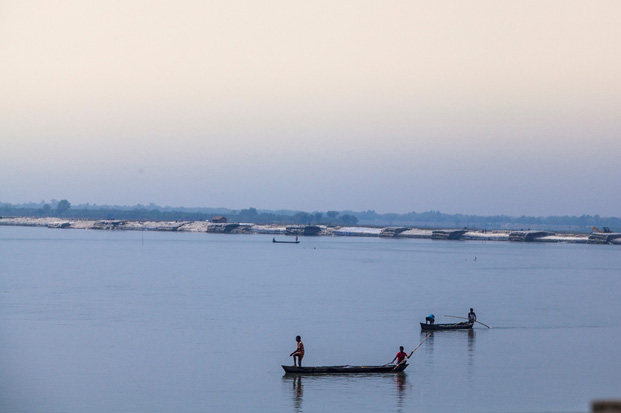Kathmandu, September 24 – A recent UNESCAP disaster-risk focused report has identified transboundary river basins in South Asia as disaster hotspots. One such area in the Hindu Kush Himalayan region is the Koshi Basin. Covering approximately 75,000 km2 across the borders of China, Nepal, and India, the Koshi Basin directly supports over 40 million people and a rich biodiversity. It is, however, also highly prone to disasters – glacial lake outburst floods (GLOFs), landslides, and floods – that are transboundary in scale and have trans-border implications.
Against this backdrop, a two-day country level consultation, titled “Koshi Disaster Risk Reduction Knowledge Hub (KDKH) Nepal Country Consultation: Building a resilient Koshi Basin,” was organized in Kathmandu from September 23-24 to bring together representatives from the government, public, private and development sectors to a common platform and discuss strategies to improve disaster risk reduction (DRR) within the Koshi Basin. Shambu Regmi, Chief of the National Operation Emergency Center at the Ministry of Home Affairs, highlighted the Disaster Risk Reduction National Strategic Plan of Action (2018-2030), which has defined priority actions for comprehensively understanding disaster risks and for improving collaboration as well.
“The KDKH hub can play an important role in contributing to trust building among countries within the basin, as well as utilising diplomatic channels leveraging ICIMOD in the region,” said Ram G. Kharbuja, Joint Secretary, Ministry of Energy, Water Resources and Irrigation.
In a session on identifying priorities of the Nepal government with respect to DRR, Krishna Hari Pushkar, Secretary, Ministry of Internal Affairs and Law, Province 2, stated that they had no shortage of access to technical publications. “The KDKH could work with us to make this information more useable,” he said. The forum also brought inputs from federal and provincial level representatives who spoke of a host of challenges ranging from greater communication among ministries to access of relevant information for at-risk communities.
The KDKH aims to strengthen a basin perspective while creating space for interaction between researchers, policy makers and practitioners for informed policy making. This KDKH country consultation in Kathmandu marks an important milestone in strengthening transboundary cooperation on the Koshi by bringing forth Nepal’s perspectives, challenges, issues and good practices in the basin.
“The Koshi Basin has unique challenges in the upstream and downstream and, thus, solutions need to be tailor made,” said Laxman Adhikari, Ward Chairperson of Khumbu. Commenting on the remoteness of the region, Adhikari said that along with area-specific DRR plans, benefit sharing from DRR is also essential. In his view, motivating communities to be part of the DRR process would be essential in making any risk reduction planning a success.
The meeting discussed the formation of a country-level chapter that will conduct working groups on topics such as glacial lake outburst floods, floods, landslides and sedimentation, and community-based disaster risk management. A technical working group is to be formed to work further on the structure of the country chapter under the leadership of the government, with support from the public, private and development partners. “The National Planning Commission supports the formation of the country chapter for the Koshi DRR Knowledge Hub,” said Dr. Dil Bahadur Gurung, Member, National Planning Commission.
“The development plan and DRR must go in hand-in-hand. The hub can function as a think tank that can support development in the Koshi Basin, in partnership with stakeholders in Nepal and its neighbours,” said Badri Dhungana, Joint Secretary, Ministry of Forests and Environment. Dr. David Molden, Director General, ICIMOD, remarked that disasters knew no administrative boundaries and that collaboration across sectors and boundaries was needed to reduce risks. The Koshi DRR Knowledge Hub is reaching across boundaries, he added.
Addressing the event, Resident Representative of UNDP Ayshanie Medagangoda Labe highlighted the collaboration and trust among all partners to build a resilient koshi and nation as a whole. Highlighting the recent UNDP and ICIMOD’s study, which shows 42 Potentially Dangerous Glacial Lakes in koshi basin, Labe committed to work more on reducing the glacial lake outburst flood risk reduction and enhancing the livelihood of vulnerable communities in the downstream.
The consultation workshop was organized by Koshi Basin Initiative (KBI) at the International Centre for Integrated Mountain Development (ICIMOD), in collaboration with the National Planning Commission. It was also supported by the Central Department of Hydrology and Meteorology at Tribhuvan University, Disaster Preparedness Network–Nepal, the International Water Management Institute, Lutheran World Relief, UNDP, and UNICEF
Koshi DRR Knowledge Hub (KDKH)
The Koshi DRR Knowledge Hub (KDKH) has been conceptualized as a platform led and driven by members to foster transboundary collaboration and promote science–policy–practice interlinkage for water-related disasters. The hub was developed through a consultative process with stakeholders between December 2017 and December 2018 to address DRR in the basin as a multifaceted, interdisciplinary, and transboundary issue. The consultative process was led by the Koshi Basin Initiative at the International Centre for Integrated Mountain Development (ICIMOD), which is now the Secretariat of the KDKH, with support from several partners across the basin who have been collaborating to comprehensively understand the disasters in the basin and enhance its resilience.

 Locations
Locations





